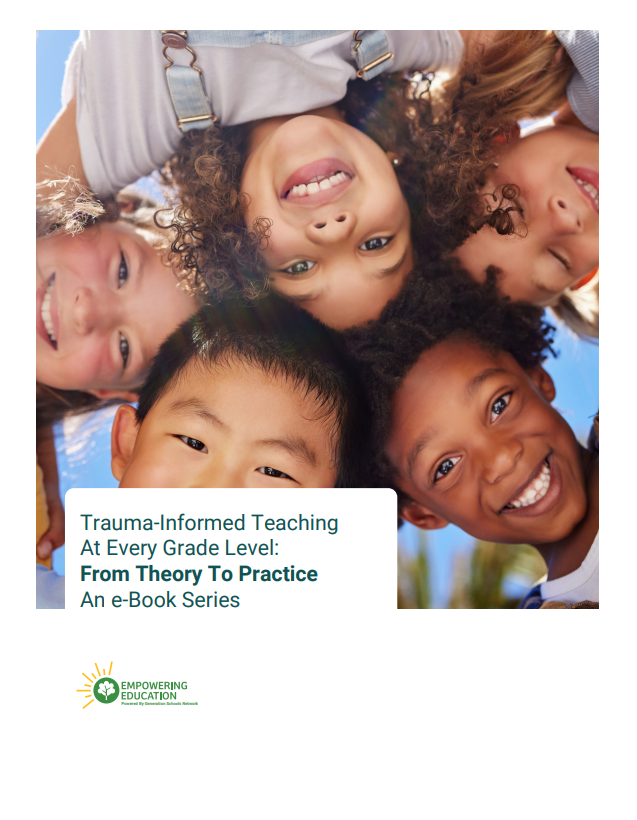As we set aside the outdated ‘suck it up’ approach to emotions and actually begin to recognize the complex and nuanced inner-lives of our students, many teachers find themselves in new territory and uncertain how to balance a sense of healthy challenge with emotional sensitivity. If a student is having a meltdown because they don’t want to take a test, for instance, do I acquiesce to their emotions or push them to rise to the occasion? If a student is constantly isolating because they have social anxiety, is it my place to push their comfort zone? Essentially: is some amount of stress good for us? And how do I know when it is too much?
The answer is: complicated. There is no one-size-fits-all approach to stress and trauma, and your response in any given situation is necessarily a reflection of your personal judgment and your relationship to that student. These questions are important, however, because they reveal a fundamental misunderstanding about what it means to be ‘trauma-informed’ - being a trauma-informed educator does not mean that we need to protect our students from all possible stressors and difficult experiences, rather, it means we have a deeper understanding of our students’ emotional states and we work to empower them to respond effectively to challenges and stressors.
Stress vs. Trauma
First, let’s clarify what we mean when we use the words stress and trauma.
From a biological perspective, stress is our body’s adaptive response to threatening stimuli. In this sense, stress is actually a highly-functional and useful emotional state. When stressed, the body releases hormones like cortisol and adrenaline that actually sharpen our mental focus and give us a physical edge (for a short period of time). This is an incredibly useful response in the context of human evolution and survival scenarios, but less so when we’re simply trying to get through morning traffic or navigate the lunchroom.
Trauma, on the other hand, is what occurs when our response to a threatening stimuli does not work. Again, this response makes sense from an evolutionary perspective - if no solution is possible, the best solution is to check-out (dissociate).
The major difference between stress and trauma, then, is our capacity for solution. This is often referred to as the window of tolerance. The more resilience, agency, and ability to take effective action that someone has, the greater their window of tolerance and the less likely they are to be traumatized. Conversely, someone who has a low sense of self-efficacy can experience even minor stressors as traumatic events.
Expanding the Window of Tolerance
The window of tolerance can be loosely described as the amount of stress we can physically and mentally handle before we either panic or shut-down. While every person will have a different internal capacity, the beautiful thing about the window of tolerance is that it can be expanded through a variety of means. These include teaching proactive coping skills, mindfulness practices, effective communication skills, and even dealing with difficult and stressful life events.
Perhaps one of the most commonly missed or misunderstood aspects of trauma is that trauma is actually an unintegrated resource. This means that those who have survived something traumatic and have successfully come out the other side often have a greater window of tolerance and a deeper sense of resilience than those who have not. We tend to conceptualize trauma-survivors as victims when in reality most of our greatest heroes have often endured the most difficult hardships. Malala Yousfazai, the young woman who survived an assassination attempt by the Taliban, is an example of someone who survived a horrific and traumatic event but then went on to become a Nobel Peace Prize winner. For her, the experience of trauma actually strengthened her inner resolve and resilience.
The key takeaway here is that a person’s (or group’s) window of tolerance can actually be expanded and strengthened through difficult experiences that are properly integrated. In this way, we may come to see that those students in our classroom who have survived traumatic experiences actually have the deepest potential reserves of willpower and strength. If we as parents and educators remove all stress from a child’s life we are robbing them of their richest opportunities for growth. Our focus should be on preparing and supporting students in responding effectively to stress rather than removing stress from their lives.
How much is too much?
The essential question this leaves most educators or parents with is: when do I push, and when do I back off? The answer to this question will inevitably be a function of your personal judgment in the moment and your relationship to the student in question. There are certainly times when pushing a student towards stress is in their best interest, and there are times when this will not serve them or your relationship at all. So how do you know the difference?
Teaching Strategies for Students who Have Experienced Trauma
A general strategy is to develop a sense of each student’s overwhelm point (or the upper limits of their window of tolerance). While this threshold will be different for every student, there are common physiological and emotional symptoms we can expect when a student is approaching overwhelm.
Signs of genuine panic (fight or flight response: rapid breathing, dilated pupils, tense muscles, and volatile emotions) are a clear indication that the student is rapidly approaching their overwhelm point. This is a good time to provide space, safety, and comfort rather than push them further.
Signs of dissociation and disconnect (checked out, spacey, numb, nauseous, sleepy, hopeless) may be a sign that the student has already exceeded their threshold and moved into a state of overwhelm and collapse. This is another good time to provide safety and structure and not push further.
Mild agitation, fear, anxiety, and even anger, on the other hand, might be indicators that the student is actually operating within their window of tolerance and can still be actively challenged to move towards a solution.
Just as we might scaffold academic instruction to accommodate varying intellectual capacities, our social-emotional interventions will require a similar scaffolding approach to accommodate varying emotional capacities. Interestingly, the more that we develop and expand our own window of tolerance, the more ability we will have to be present with difficult emotions in the classroom.
The bottom line with stress and trauma: when students feel safe, they learn. This does not preclude the possibility of stress. In fact, the optimal conditions for learning include both safety and stress. When we provide the structure, resources, and support for students to succeed they will naturally want to challenge their abilities and move towards difficulties.
 About the Author: Cody Wiggs is the author of Empowering Minds (A K-8 Mindfulness-Based SEL Curriculum), the Executive Director of Empowering Education, and a therapist specializing in the treatment of post-traumatic stress and treatment-resistant depression. He has been designing and implementing social-emotional programs for the last seven years. He has also been working with youth for the last decade in a variety of settings from school counseling, wilderness therapy, international service learning trips, community organizing, and private practice. Cody is a licensed professional counselor, a licensed school counselor, a certified yoga instructor, and a long-time practitioner of mindfulness. His work is informed by his travel and study of indigenous healing practices in SE Asia, South America, and North America.
About the Author: Cody Wiggs is the author of Empowering Minds (A K-8 Mindfulness-Based SEL Curriculum), the Executive Director of Empowering Education, and a therapist specializing in the treatment of post-traumatic stress and treatment-resistant depression. He has been designing and implementing social-emotional programs for the last seven years. He has also been working with youth for the last decade in a variety of settings from school counseling, wilderness therapy, international service learning trips, community organizing, and private practice. Cody is a licensed professional counselor, a licensed school counselor, a certified yoga instructor, and a long-time practitioner of mindfulness. His work is informed by his travel and study of indigenous healing practices in SE Asia, South America, and North America.


